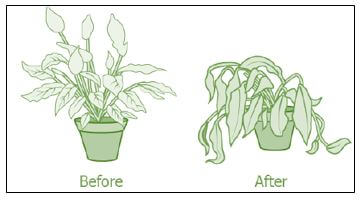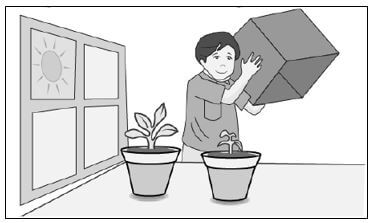The Living Organisms – Characteristics and Habitats Worksheet
Objective Type Questions
- Write the habitat of each plant/animal shown in the figures (a) to (d). Choose your answers from the choices given in the brackets.
(Grassland, Pond, Ocean, Desert, Mountain, Forest) - Some clues are provided below. Based on these clues, identify the animals. Select your answer from the choices given in the brackets.
(mountain goat, polar bear, whale, deer, lion, snow leopard, camel, frog)
(a) I have white fur on my body. I live in the polar regions.
(b) I have strong back legs and webbed feet. I live in ponds.
(c) I have blowholes to breathe in air. I live in the sea.
(d) I have strong teeth, long ears, and eyes on the side of my head. I live in grasslands.
(e) I have strong hooves. I live in the mountains. - Match the terms in column A with appropriate terms in column B.
Multiple Choice Questions - Animals like camels can survive in a desert. Which of the following features in a camel helps it to survive in the desert?
(a) Hump produces food
(b) Long neck helps to store more water
(c) Long legs protect from the heat of the sand
(d) Thicker skin helps in the transpiration of more water - Polar bears living in the cold regions have long hairs on their body. How do these hairs help these animals to survive in the cold regions?
(a) Keep their body warm
(b) Help them to run faster
(c) Help them to swim in water
(d) Absorb water from the atmosphere - Two potted plants were covered with polythene bags – one had a desert plant and the other had a land plant. If these plants were kept in sunlight, what would you observe?
(a) Desert plant releases more water in the polythene bag
(b) Land plant releases more water in the polythene bag
(c) Both the plants release the same amount of water
(d) Both the plants do not release water - The table lists few abiotic components and its availability in different habitats.
The availability of which abiotic components is correctly explained in the given table?
(a) Only light
(b) Only gases
(c) Both light and temperature
(d) Both gases and temperature - The picture shows a plant which was left near a sunny window unattended for few weeks.
What can be concluded based on the observation?
(a) Water is essential for the plants to survive.
(b) Presence of water makes the leaves green.
(c) Plants grow stronger in the absence of water.
(d) Plants can absorb water from the atmosphere. - Kunal performed an experiment in which he planted two similar plants in two different pots. He covered one plant with a carton and placed the other plant close to the window. He provided equal amount of water to both the plants. After 10 days, he observed the growth of the plants which is depicted below.
Which of these statements can be concluded based on the activity?
(a) Plants produces their own food.
(b) Plants require sunlight to grow.
(c) Plants can survive without air and water.
(d) Growth of a plant depends only on the supply of water. - Cactus is a desert plant which lacks leaves but instead has a thick stem which is responsible for photosynthesis. Why are leaves absent in the cactus plants?
(a) Leaves would have wilted easily in the strong desert Sun.
(b) Leaves are absent to save the plants from the predators.
(c) Leaves would have caused increased loss of water from the plant.
(d) Leaves are reduced to spines to protect from cold nights in the desert. - Snakes do not have protective modifications like camels and coyotes, to survive under the hot desert Sun for a long time. Still, how are they considered to be a part of the desert’s biodiversity?
(a) They only reside in a desert wherever there is an oasis.
(b) They have a slimy coating which makes it easier for them to slither through the sand.
(c) They are nocturnal and mostly stay deep underground during the day.
(d) They are less mobile in a desert and feed on whatever is available nearby. - Fishes and mammals such as dolphins and whales live in an aquatic habitat. Fishes respire underwater through their gills. However, dolphins and whales do not have gills. How do they breathe to survive in aquatic habitats along with fishes?
(a) They respire through their skin.
(b) They absorb the gases dissolved in the water.
(c) They absorb the gases through the membranes present in their fins.
(d) They hold their breath underwater and come up to breathe the air via nostrils. - A child has a trouble in understanding that all plants are living organisms, just like humans. However, the child is not convinced as plants cannot move around like humans, other animals, birds, and fishes. Which of the following can be told to the child to make him understand that even plants are living things, like humans?
(a) Plants can absorb water from the soil.
(b) Plants are present in large numbers and variety.
(c) Plants can reproduce and create new plants similar to themselves.
(d) Plants are found in both, terrestrial and aquatic habitats.
Subjective Questions - Why high-altitude climbers need to have a stay at their base camp before they start the climb?
- potted plant was growing upright. However, accidentally it got overturned and started growing as shown below. How would you explain this phenomenon?
- Given below are few plants and their adaptations. Study them carefully and pick out the correct point of significance of each of these adaptations for the respective plants.

Case-Based Questions - Habitat is the natural dwelling place of an organism. In a habitat, both biotic and abiotic components live in close inter-relationship with each other. Habitats can be broadly classified into two types – aquatic and terrestrial habitats. Lakes, rivers, and oceans are some examples of aquatic habitats. Organisms found in the aquatic habitats include fish, frog, shark, coral reef, and duck. Forests, grasslands, deserts, coastal and mountain regions are included under terrestrial habitats. Terrestrial habitats include organisms such as camel, gorilla, sloth, wolf, and eagle.
a) Which of the following correctly defines a habitat?
(a) The place where an organism lives
(b) The area in the vicinity of an organism
(c) The place where both biotic and abiotic components are found
(d) The area in which an organism lives and its surrounding places
b) Which of the following shows the inter-relationship between biotic and abiotic components of a habitat?
(a) Host-parasite relationship
(b) Rainfall provides moisture to the soil in which plants grow
(c) Prey-predator relationship
(d) Decomposers feed on dead and decaying animals.
c) Classify the following as biotic and abiotic components.
d) Which of the following is not found in a terrestrial habitat?
(a) Bear
(b) Walrus
(c) Jaguar
(d) Starfish
- Living things have certain common characteristics – they need food, they respire, and excrete, respond to their environment, reproduce, grow, and show movement.
The given picture is of a caterpillar. Based on the given picture, answer the following questions:
a) Which feature of caterpillar is shown in the picture?
(a) Growth
(b) Reproduction
(c) Breathing through tiny pores on its bodies
(d) Response to changes in the environment
b) Which of the following shows the same feature as that shown by the caterpillar in the given figure?
(a) Fishes use gills for absorbing the oxygen in water.
(b) Leaves of touch-me-not plant close when someone touches them.
(c) A chick grows into a hen.
(d) Plants produce seeds.
c) How does the green colour of the caterpillar help it to survive?
Assertion-Reasoning Questions
Below questions consist of two statements – Assertion (A) and Reason (R). Answer these questions selecting the appropriate option given below: - Assertion (A): Adaptation is a method by which organisms get well adjusted to their surroundings.
Reason (R): Adaptation does not take place in a short time.
- Assertion (A): Polar bear has padded feet while the yak has sharp hooves and horns.
Reason (R): These adaptations help the animals to protect themselves from the cold temperature, snow, and chilly winds.
Explore more Science Sample papers and Solutions
-
Sample Papers for CBSE Class 6 Science Term 1 #1
-
Sample Papers for CBSE Class 6 Science Term 2 #1
- Components Of Food Worksheet
- Sorting Materials Into Groups Worksheet
- Separation Of Substances Worksheet
- Getting To Know Plants Worksheet
- Body Movements Worksheet
- Motion And Measurement Of Distances Worksheet
- Light, Shadows And Reflections Worksheet
- Electricity and Circuits Worksheet
- Fun With Magnets Worksheet
- Air Around Us Worksheet
- Competency Based Questions for CBSE Class 6 Science
- Sample Papers for CBSE Class 6 Science Term 1 #2
- Sample Papers for CBSE Class 6 Science Term 2 #2










